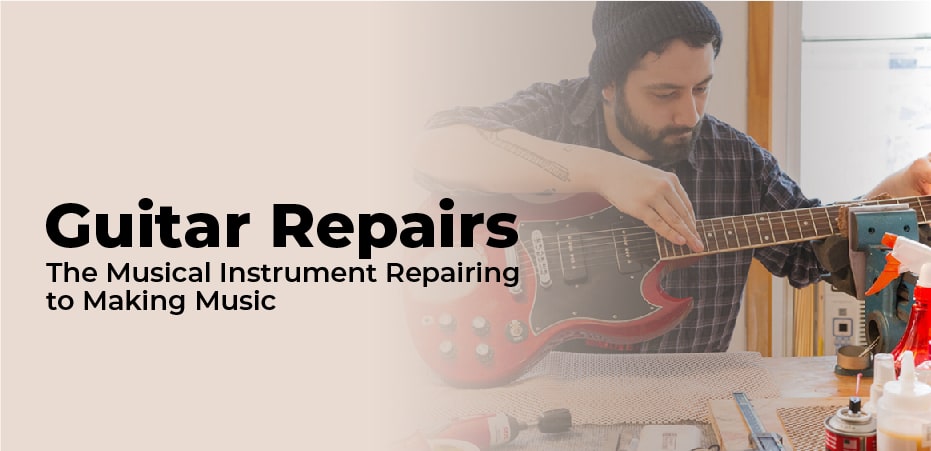Table of Contents
We offer a complete luthier’s service at Sever Instruments & Accessories. All kinds of guitars, basses, and other instruments are repaired and maintained by us. We provide professional care for your musical instrument by our skilled master luthiers. Our guitar repair and building expertise date back generations. We treat every instrument with the utmost attention to detail. Only professional luthier tools are used for each procedure.
We recommend you schedule an appointment with our master luthier. He will inspect your instrument and discuss further procedures with you. Here are his contact details.
Our guitar repair and maintenance of different types of instruments have a long tradition dating back to the late 1970s. It represents a link with constant activities and a presence on the market. We also see this sector of our work as an opportunity to interact with musicians, on the one hand, and us, on the other hand, providing quality luthier services. Due to this direct contact, we can provide a complete luthier service. We receive valuable feedback in this way, and we strive to meet musicians’ demands at all times. This results in high quality service and instruments for both parties.
The Different categories of Guitar Repairing & Maintenance:
Tone & Playing Characteristics of Your Instrument Improved:
when you corrected your incorrect neck positioning and shape. The three most important parameters are: neck inclination, neck set up symmetry, and neck centralization, and finally neck relief (the correct concave bended neck profile). When these three factors are in perfect alignment, we achieve optimal swinging and amplitude conditions, as well as smoother and more pleasant playing conditions.
We can play faster, smoother, and with less effort with this professional set-up. There is no annoying buzz of the strings bouncing on the fretboard. The produced tones are crystal clear.
Repairing Malfunctions:
In addition to any deviation from the expected functioning of the instrument, malfunctions can be caused by external forces such as falls, cracks, shocks, etc. The instrument may also malfunction due to normal wear and tear. The most common type is neck cracks at the point of the neck-head joint. Machine heads, potentiometers, knobs, pot necks, and nuts can also suffer damage from cracks. These are usually caused by improper transport. Hidden errors are particularly common with electronic parts. These repairs require specialized tools and measuring equipment. Wooden parts can be repaired the easiest. We have quality replacement parts in stock for the occasions when parts need to be replaced.
Using Existing Parts to Improve Playing Functions:
Malfunctions of this type are usually the result of improper installation of existing parts, long term storage, and transportation impacts. For new guitars, higher action is usually set up to avoid string buzzing at the frets. Due to changing conditions during the transport time, producers use that kind of setting. When using a new instrument from the shop, it should be thoroughly inspected and set up. Each instrument from Sever has already been optimally adjusted.
When customers buy a new instrument, they are frequently disappointed. It is usually the case that guitars do not have high action, resulting in a difficult and laborious playing experience. A proper adjustment of the new instrument as well as teaching the user some basic technical instrument maintenance can help prevent all of these problems.
Installation Of New Parts Or Replacement Of Existing Parts:
cannot always be attributed to a malfunction. An instrument’s tone characteristic can be substantially improved by carefully selecting new quality parts. It is common for us to change pickups, electronics components, machine heads, nuts, and bridges. The kind of operations we can perform can be divided into two categories: simple changes in the existing holes, pickups, jacks, pots, etc., or more complicated procedures that require drilling new holes in the pickups or other components. In addition to being more expensive, the latter also takes more time to complete.
Fret changing is the most common intervention. Whenever frets become worn out to the point where they cannot be improved with sanding and leveling, we have to replace them with new ones. For stainless steel frets, the operation takes five to seven days. It is possible to change them in one day, but in this case, we cannot guarantee the quality of the work because the resting period that prevents tension in wooden parts has been omitted. There are various ways to change the frets, depending on the neck design. For classical guitars, changing the frets is the simplest solution (flat fingerboard, no binding, softer frets). Operation on better quality classical guitars with ebony fingerboards is far more challenging.

